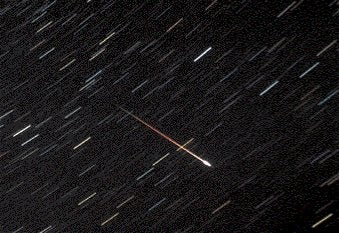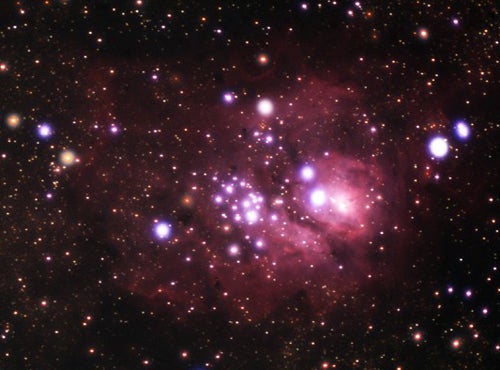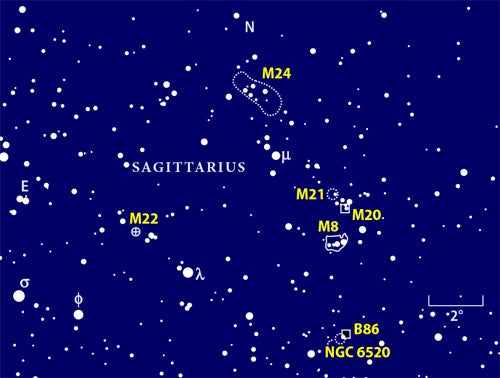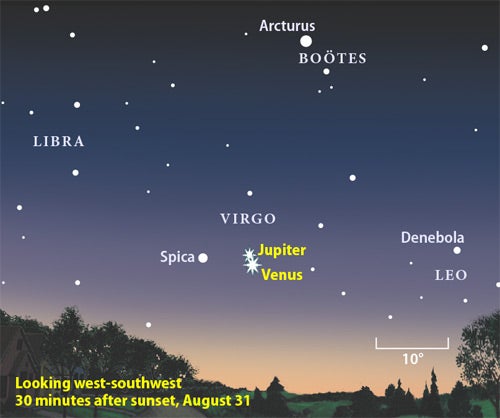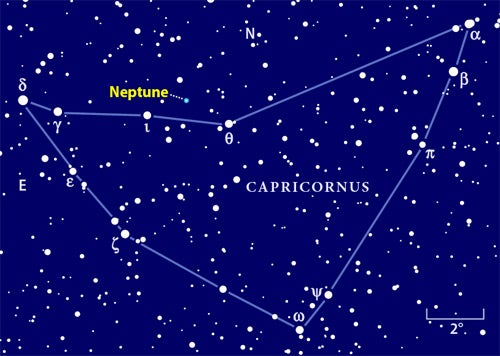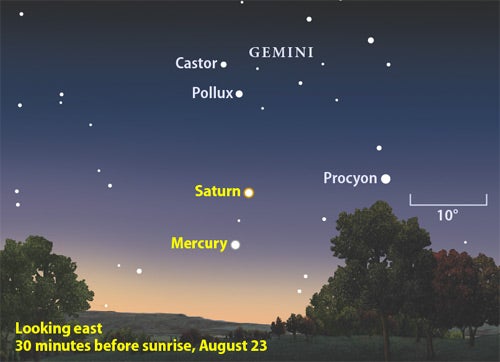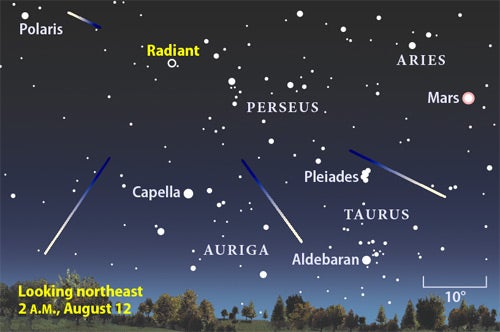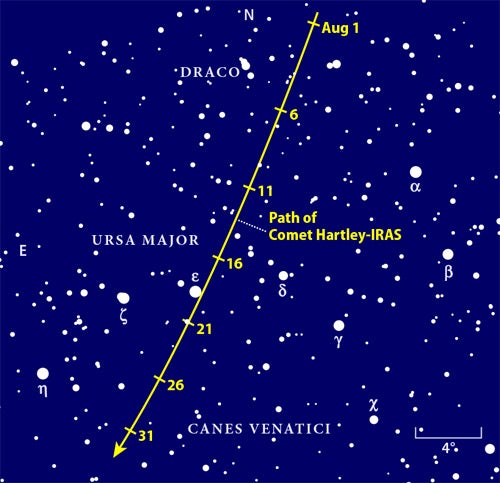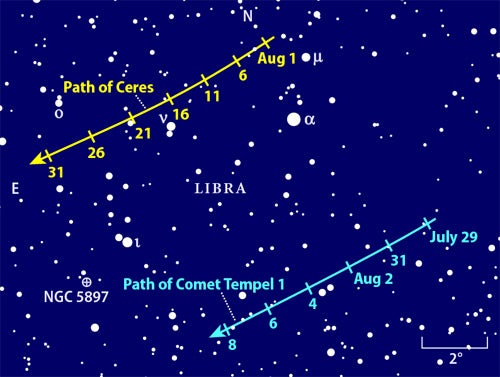An enjoyable activity on a sunny summer day is to view the Sun. If you don’t have a safe solar filter, head to the nearest planetarium or science center. Chances are it will have set up solar telescopes, and you can talk to a knowledgeable person about proper filters.
The first thing you’ll notice on the Sun’s disk are several black dots — sunspots. During the course of an afternoon, you often can see a large sunspot change structure slightly. If you can look through an H-alpha filter, you’ll likely see one or two prominences, large tongues of red flame that arch above the solar limb.
Jupiter puts on its last telescopic hurrah during August. The bright, pale-yellow “star” low in the west-southwest after sunset is the biggest planet in the solar system. The earlier in the evening you observe it, the better chance you have of a good look. When an object lies low in the sky, its light travels a longer path through Earth’s lower atmosphere, increasing the chances of encountering image-spoiling turbulence.
Because Earth orbits the Sun faster than Jupiter does, the giant planet appears to sink toward the Sun. This sets up a conjunction with Venus at the end of August. The two planets lie low in the sky during twilight, however, so they won’t be as impressive as in November 2004’s morning sky.
Will Comet 9P/Tempel 1 sport a spike this month? Astronomers hope the July 4 slap across the face from the Deep Impact spacecraft will create a new jet for all to see. The dirty snowball hangs low above the southern horizon as the sky darkens. Another comet, 161P/Hartley-IRAS, remains in view near the Big Dipper all night.
Although the Moon lies in hiding at the start of the month, it climbs into the evening twilight to pair with Venus August 7. Because of the objects’ low elevation, this will be a binocular event for most of us. In Alaska and the Yukon, the Moon blots out Venus just before sunset. You’ll need a carefully orchestrated plan to bag this rare event.
If you think the Moon looks lower than normal, you’re not crazy. From First Quarter to Full Moon, our satellite lies almost as far south as it can get. It hits the “bottom” of its 18.6-year cycle next summer. From south of the equator, the Moon reaches its high point.
With summer nights so short, it’s easier to stay up until dawn. Mars appears high in the south by this time, its bright orange glow seemingly out of place in this quiet area of sky. Although small, Mars’ disk has grown big enough to reward patient observers with subtle details. Magnificent Saturn will keep you going until Mercury breaches the horizon. The crescent Moon joins the parade the mornings of August 31 to September 2.
Clusters near the core
Although the small constellation Coma Berenices doesn’t look like much to the naked eye, it packs a full complement of splendid deep-sky objects. Two months ago, we focused on the constellation’s northern end. This month, we tackle the Blackeye Galaxy, a pair of globular clusters, and some double stars on the southern side.
Aim your binoculars at the brightest section in the south. Here, you will see a misty glow — the Lagoon Nebula (M8) — summer’s answer to winter’s great Orion Nebula. Hot, young stars flood this neighborhood with high-energy radiation, making gas clouds glow. Just above the Lagoon lies another star nursery, the Trifid Nebula (M20). You’ll need an 8-inch scope to see clearly the dark lanes that give this nebula its name. A group of teenage stars, M21 has shed its natal cocoon, making it easy to spot its brightest members through binoculars. Keep sliding north and you’ll soon run across an amazing concentration of stellar pinpoints — the Small Sagittarius Starcloud (M24).
Spend some time observing M24 through a telescope. Start at low power to get an overall picture, and sweep around slowly, watching how the star density changes. It’s as if a celestial artist had flicked a brush full of black paint onto the canvas, obliterating stars in random blobs. Once again, this is light-years of dust blocking our view. One day in the distant future, this dust will be processed into stars and planets. Bump up the power to get a good look at the nearly innumerable stars filling the eyepiece.
The mismatched pair NGC 6520 and B86 ranks among many observers’ all-time favorites. From the city, it’s a ho-hum sight — don’t disappoint yourself. Under dark skies, the lovely star cluster NGC 6520 sits on a concentrated bed of fine stardust, making a stark contrast to the jet-black dust cloud Barnard 86 immediately adjacent. For maximum punch, center a big scope operating at about 250x on the black space. Then, let Earth’s rotation carry in the astonishing mass of stars crowding the galaxy’s inner spiral arms.
The two brightest planets — Venus and Jupiter — begin August 30° apart in the western sky after sunset, and will appear to get closer during the month. At magnitude –3.8, Venus shines 2 magnitudes brighter than Jupiter. Venus’ elongation from the Sun increases this month, but the planet continues to hug the horizon as it moves south in declination. During the next few months, Venus will set farther south of due west just like the Sun.
Jupiter lies about 5 times farther from Earth than Venus. But with nearly 12 times the physical diameter of Venus, Jupiter shows a significantly larger disk through a telescope. This month, Jupiter measures 33″ across.
Each evening during August, Jupiter and Venus appear 1° closer to each other. Do the math, and you’ll find the two are destined to be next to each other by month’s end. On August 31, the two bright planets lie just 4 Moon-widths apart, making a stunning evening pair. They’ll appear slightly closer the first evening of September.
Jupiter sets earlier each night, so quality observing time dwindles throughout the month. On August 1, it sets around 11 P.M. local daylight time. By the end of the month, it disappears from view near the end of twilight.
A small telescope easily reveals the wanderings of Jupiter’s four Galilean moons. If you’re a newcomer to watching Jupiter, it’s worth spending time identifying each moon. Make a sketch of their positions relative to Jupiter each clear night. You’ll soon notice some patterns emerging in each moon’s motion. Io, the innermost large moon, scoots around Jupiter in less than 2 days. Callisto, the outermost major moon, takes more than 2 weeks to complete a single orbit of Jupiter.
Going from one extreme to the other, Pluto is the smallest, faintest planet in the solar system. It lies in the southwestern corner of Serpens Cauda, 2.5° west of the 3.5-magnitude star Xi (ξ) Serpentis. You’ll need an 8-inch or larger telescope and a transparent, moonless sky to find the outermost planet, which glows at magnitude 13.9.
Neptune’s closer cousin, Uranus, reaches opposition the American evening of August 31. (In Europe, Africa, Asia, and Australia, the calendar reads September 1.) This is the best time of year to view this distant gas giant. Look for it near local midnight in the southern sky. Uranus lies in the same binocular field of view as Lambda (λ) Aquarii, and is itself an easy binocular target. It glows at magnitude 5.7 and looks just like a star of that brightness. A telescope easily reveals its 3.7″-diameter disk, which has a distinct blue-green color.
Mars enters the late evening sky during August, and rises well before midnight by the 31st. It still appears best before dawn, however, when it lies high in the south. The planet’s south polar cap continues to erode as summer begins in that hemisphere (the summer solstice occurs August 16).
This seasonal moment places the south polar cap on fine view for earthbound observers, while the northern cap tilts away from us. Mars exhibits a strong gibbous phase during August, although it does diminish slowly. Last month’s minimum of 84 percent illumination grows to 87 percent by August’s end. Any telescope will show the planet’s orange disk as distinctly non-round.
Mars brightens rapidly during August as its distance from Earth decreases. It reaches magnitude –1.0 August 31, about 60-percent brighter than early in the month. This coincides with its distance from Earth dropping from 77 million miles to 62 million miles. As you might guess, Mars also appears larger when viewed through a telescope. Its disk grows more than 20 percent during August, from 11.3″ to 14.0″. By the time Mars reaches opposition in early November, its disk will appear nearly 50-percent larger.
As the south polar cap slowly disappears, watch carefully for cloud features that likely will appear around the polar cap and along the terminator. Colored filters designed for planetary viewing will aid their visibility. Other familiar martian features also exhibit changes, including Syrtis Major, Solis Lacus (the “eye of Mars”), and the Hellas basin. Now is the time to start observing carefully. Photograph or sketch what you see so you become familiar with these features by the time the best views arrive around its November 7 opposition.
As if to complement the great Venus-Jupiter conjunction in the evening sky, Saturn and Mercury meet each other in a more subtle pairing before dawn. After August 20, both planets should be easy to spot low in the east-northeast an hour before sunrise. Saturn then shines at magnitude 0.3, and Mercury, located 6° below Saturn, shines at magnitude 0.4. During the remaining days of August, Saturn continues to rise earlier, while Mercury draws away from Saturn. Mercury continues to brighten through the end of the month. On August 31, it shines at magnitude –1.0. Saturn stands 16° higher, with a slender crescent Moon just 5° to its north. Next month, Mercury will pass close to Leo’s brightest star, Regulus.
The August 19 Full Moon occurs just 12 hours after perigee, the Moon’s closest point to Earth. Our satellite will then appear 10-percent larger than average, spanning 33.25′.
Although the Perseid meteor shower isn’t always the most prolific, it ranks among the most famous because it occurs during the balmy nights of August. This year, peak activity comes August 11/12, but expect significant activity the next night as well. The shower’s radiant — the point from which the meteors appear to emanate — lies in Perseus a few degrees northeast of the Double Cluster. It rises to a decent altitude in the northeast by midnight but climbs still higher in the hours before dawn. The Moon is just past its First Quarter phase and sets before midnight, so dark skies should prevail for this steady annual shower.
Observers who venture to a dark site can expect to see an average of one meteor per minute in the early morning hours. (The key word here is “average” — you could go 10 minutes with no meteors and then see 20 in the next 10 minutes.) Certainly, the Perseids rank among the best showers of any year, and this year, they bring the added benefit of a moonless sky. Next year, a nearly Full Moon will spoil the view, so make the most of this summer’s fine display.
Few families have the astronomical pedigree of the Herschels. William (1738–1822), who discovered the planet Uranus in 1781, his sister Caroline (1750–1848), and his son John (1792–1871), were all talented observers and telescope makers. And each is honored with a crater on the Moon.
On August 16 and 17, the Sun rises over this area north of the well-known feature Sinus Iridium. A prominent double crater on J. Herschel’s southwestern wall runs into Mare Frigoris. A linear wall or ridge runs from this crater pair to the northwest, creating J. Herschel’s western boundary.
Inside J. Herschel’s 97-mile-wide polygonal wall lies a complex region of hills and small craters. The largest of these craters lies at the center. North of J. Herschel you should see two other craters: 37-mile-wide Carpenter and the adjacent 42-mile-wide Anaximander. Pythagoras is the name of the prominent crater located west of J. Herschel and closer to the limb. Pythagoras’ central peak dominates this crater’s center.
Periodic comet 161P/Hartley-IRAS slices through the Big Dipper asterism in Ursa Major, putting it on display all night. This is the comet’s first return since its discovery 21 years ago. Although some sources expect it to brighten to 8th magnitude, making it just visible through binoculars from a dark-sky site, others suggest a fainter appearance at 11th magnitude.
Astronomers usually give a comet’s total magnitude, in other words, how bright it would appear if all its light were scrunched into a point. Start at, say, 10th magnitude, which would be easy to see as a point source through a backyard scope. Now spread the light out into a diffuse disk, and it behaves more like a galaxy and can disappear behind the veil of city light pollution.
To find Hartley-IRAS, head for the country at either the beginning or end of the month, when moonlight isn’t a problem. Star-hop your way to its location with the help of the finder chart at upper right. Don’t use a bright flashlight — it will compromise your dark adaption. Smaller comets often are not visible immediately at low power, so try something close to 100x.
If everything went as planned with the Deep Impact mission last month, the new crater blasted in Comet 9P/Tempel 1 will be producing a jet every time it rotates into sunlight. You’ll need to observe from a dark site with at least a 4-inch scope. The best views will come between July 29 and August 8, when the Moon is out of the evening sky. Because no one has ever punched a comet in the face before, we won’t know if the impact created a bright new jet unless we look.
While you’re in Libra, swing your scope over to globular cluster NGC 5897. It’s a modestly large but diffuse object easily hidden by poor sky -conditions. Its brightest stars crest at 13th magnitude, so you’ll need a 10-inch scope at medium to high power to begin to resolve it into hundreds of faint speckles.
Subtle Ceres
Despite its large size (595 miles in diameter), Ceres looks like an ordinary field star glowing at magnitude 8.6 when it lies more than 200 million miles away. You can find it the same way its discoverer, Giuseppe Piazzi, did January 1, 1801: by noting its displacement against the starry background.
Ceres moves about 15′ per night, half the apparent diameter of the Moon. To see it shift during one evening’s session, try observing the night of August 4 or 13. Each of those nights, it lies near several stars that can serve as markers. Come back after an hour or 2 to spot a change in position.

